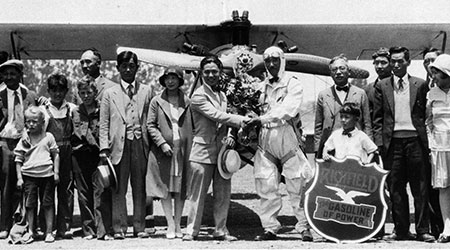Asian American Resources

This information serves as a toolkit for educators to provide historical information about Asian American communities and their experiences in the United States. While navigating these resources, educators can locate age-appropriate resources for elementary through secondary grades. Information on the Asian American Civil Rights Movement and an overview of immigration push and pull factors provide a foundation for teachers to place classroom materials and lesson plans in historical context.
Timeline ![]() Civil Rights: Organizing with Purpose
Civil Rights: Organizing with Purpose ![]() Immigration
Immigration ![]() Breaking Down Stereotypes
Breaking Down Stereotypes
 Asian American History Timeline
Asian American History Timeline

Utah's Asian American History Timeline
Designed for educators and students, this timeline covers key Asian American events in Utah and the United States. It includes immigration, locations, work, events, contributions, local leaders, laws and more.
 Asian American Civil Rights: Organizing with Purpose
Asian American Civil Rights: Organizing with Purpose
Since the earliest arrival of Asian immigrants to the United States, Asian American communities have confronted various challenges and responded with purpose. Through grassroots organizing, legal advocacy and community building, Asian Americans have been important participants in the broader landscape of civil rights in the United States. They have worked to challenge stereotypes and injustice, advocate for legislative change and demonstrate their contributions to the American story.
Responding to anti-Asian movements in the early 20th century, Japanese Americans formed the JACL to protect Nikkei rights, mainly in western states. Although an estimation, Utah's JACL chapter has been active since 1929 and has pushed to repeal the Alien Land law in Utah in 1947. Initially backing WWII incarceration for better relations, the JACL later helped secure reparations and redress. Today, the JACL focuses on civil rights, immigration, education and cultural awareness. They also back representation initiatives across the nation and formed the Japanese American Youth group.
In a pivotal 1944 Supreme Court case revisited in 1976, the constitutionality of Executive Order 9066, allowing Japanese American incarceration during WWII, was questioned. Fred Korematsu's resistance led to his arrest and conviction, upheld by the Supreme Court, citing military necessity. Despite later criticism and evidence of suppressed information, the 1976 reopening of the case maintained the original decision. The Korematsu case remains controversial, underscoring the dangers of wartime hysteria and the importance of safeguarding civil liberties and minority rights, even in times of crisis.
In the 1960s and 1970s, the Asian American movement, inspired by African American, Chicano, and anti-Vietnam War movements, addressed stereotypes, discrimination and marginalization. Led by youth, it fostered cultural awareness, unity, and community, giving rise to influential organizations such as the Asian American Political Alliance and Yellow Brotherhood. The movement successfully demanded improved representation, leading to increased visibility for Asian Americans in media, Hollywood, politics and leadership roles.
The Civil Rights Act of 1964, a landmark legislation, prohibited discrimination based on race, color, religion, sex or national origin. While closely associated with the African American civil rights movement, it also had significant implications for Asian Americans facing discrimination in employment, education and public accommodations. Establishing the Equal Employment Opportunity Commission (EEOC), the Act addressed employment discrimination. Despite the progress, the struggle for Asian American civil rights persisted, leading to ongoing support through political narratives, community organizing and legal action. The Civil Rights Act of 1964 remains a crucial milestone in the ongoing fight for social justice and equality, encompassing the rights of all Americans, including Asian Americans.
This act provided a formal apology and reparations from the US government to Japanese Americans who had been incarcerated during World War II. The law came as a response to the movement for redress and reparations for Japanese Americans that began in the 1970s.
In 1976, the Commission on Wartime Relocation and Internment of Civilians (CWRIC) issued a report that revealed WWII Japanese American incarceration stemmed from prejudice, not necessity. It birthed the National Council for Japanese American Redress. In 1983, the CWRIC re-evaluated, leading to the 1988 Civil Liberties Act, signed by President Reagan, acknowledging past injustices.
The law apologized for Japanese American wartime incarceration, granting $20,000 reparations to survivors. While it couldn't undo trauma, it acknowledged civil rights violations, paving the way for reparations discussions among other marginalized groups.
This grassroots community organization, founded by working-class South Asian and Indo-Caribbean immigrants and youth in New York City, initially aimed to address poverty, racism and discrimination. It began by focusing on improving conditions for South Asian taxi drivers but swiftly broadened its scope to include workers' rights, education and immigration. DRUM played a crucial role post the September 11 attacks in 2001, pushing against increased discrimination and surveillance of South Asian, Arab and Muslim communities in the United States.
SAALT is a national group promoting South Asian American participation in civic life and human rights. It conducts research, campaigns and education, addressing issues like immigration, profiling and hate violence. Notably, SAALT combats hate crimes, especially after 9/11, by raising awareness, aiding victims and pushing for policy changes.
This movement emerged in response to a surge in hate crimes against Asian Americans amid the COVID-19 pandemic. Gaining national attention after high-profile attacks, including the Atlanta shootings in March 2021, the movement is led by a coalition of activists and allies. Their efforts include organizing rallies, protests and social media campaigns to raise awareness about anti-Asian hate. Through various calls to action towards law enforcement and government officials they hope to address the historical yet ongoing discrimination faced by Asian Americans. The “#StopAsianHate” movement has significantly influenced public discourse and policy, proving to increase recognition of Asian American experiences and challenges, along with increased funding for anti-hate initiatives.
 Asian American Immigration
Asian American Immigration
People from Asian countries have come to the United States for various reasons, and it's not as simple as just wanting to move. Some Asians left their home countries because of tough situations like political problems, conflict or not having enough money. These difficulties pushed them to look for new opportunities elsewhere. The United States offered many pull factors, such as opportunities for work and the promise of a better life. Their journeys were not just about moving from one place to another; their stories are an important part of American history.
Examples Across History: Push Factors
The Qing dynasty (1644-1912) grappled with numerous rebellions and invasions, causing widespread violence and instability in China's economy, politics and social structure. The Taiping Rebellion, led by a Chinese Christian sect, heightened discrimination and violence, prompting many Chinese to seek safety and opportunities in the United States.
In the 19th and 20th centuries, Japanese immigrants arrived in the United States to escape economic struggles in Japan. Rapid industrialization and modernization in the 1800s led to widespread unemployment, particularly in rural areas, compelling many Japanese families to seek economic opportunities in the United States.
Amid the Vietnam War in the 1960s-1970s, numerous Vietnamese sought refuge from the war-induced violence and instability, which disrupted society and economy, leading to the loss of homes and livelihoods. Forced conscription in the war heightened danger for individuals and their families, compelling many to flee in search of safety and stability in the United States.
The 2004 Indian Ocean earthquake and tsunami, originating off Sumatra, Indonesia, led to widespread devastation in countries like Indonesia, Sri Lanka, Thailand, India and the Maldives. In response, the United States implemented temporary immigration measures, granting many refugees Temporary Protected Status (TPS) in the United States.
Examples Across History: Pull Factors
In the late 20th century, South Korean immigrants sought refuge in the United States to escape political turmoil caused by the division of Korea after the Korean War. The unrest and protests in South Korea drove many to seek stability and freedom in the United States, viewed as a protector of individual rights.
During the late 20th century, numerous Filipinos migrated to the United States to reunite with family members who had already immigrated. Engaging in jobs, particularly in agriculture and domestic work, they aimed to sponsor and bring spouses, children and other family members to the United States. Evolving immigration policies, notably the Immigration and Nationality Act of 1965, facilitated the reunification of Filipino families.
Two notable immigration trends to the United Stages emerged—one following India's independence in 1947, and another after the Immigration and Nationality Act of 1965 eliminated quotas, prompting fresh waves. Individuals from India, China, Japan, Korea and other Asian countries pursued higher education and career opportunities in the United States due to limited options in their homelands.
The United States attracted many with perceived opportunities for education, employment and upward social mobility. The powerful allure of the belief that anyone can achieve success and prosperity acted as a significant pull factor for immigrants. The country's reputation for safety, stability and high living standards appealed especially to those from nations marked by political instability, economic hardship and social unrest.
 Breaking Down Stereotypes
Breaking Down Stereotypes
 I Am Not Your Asian Stereotype
I Am Not Your Asian Stereotype
Bad driver. Math wizard. Model minority. In this insightful TEDx talk, eighteen-year-old Canwen Xu shares her Asian American story of breaking stereotypes, reaffirming stereotypes and driving competently on her way to buy rice.
 The Invisible Minority
The Invisible Minority
Growing up as a Chinese American, Mei shares her perspective of how the lack of Asian representation within the media and curriculum has impacted her and many other Asian Americans..


 UTAH EDUCATION NETWORK
UTAH EDUCATION NETWORK

 Justin
Justin Braxton
Braxton Dani
Dani Kayla
Kayla Katie
Katie Lora
Lora Rob
Rob Val
Val
